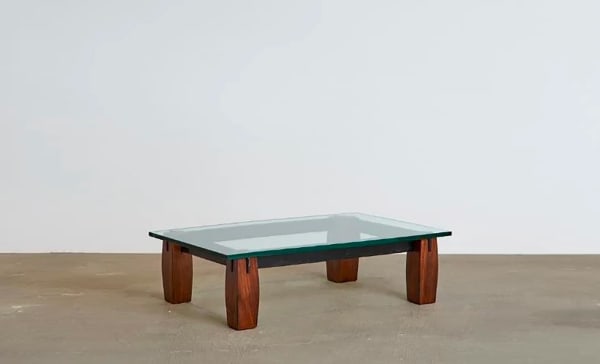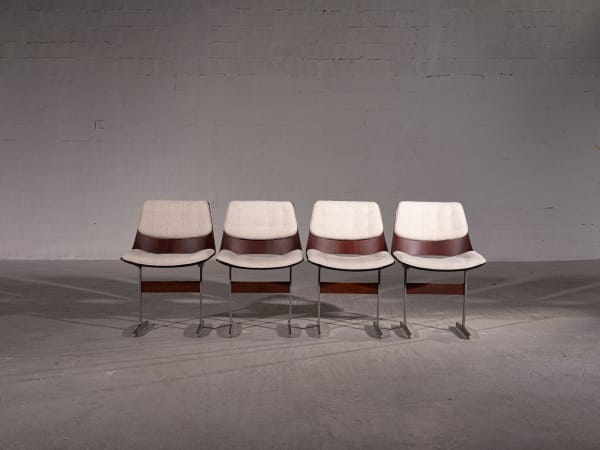Jorge Zalszupin: master of Brazilian modernist furniture
Born in 1922 in Poland, Jorge Zalszupin will know a difficult destiny before finding a place or giving free rein to his creativity. Indeed, the difficulties linked to the Second World War pushed his family into exile in 1940 in Romania, where he found the opportunity to train at the School of Fine Arts in Bucharest, then at the Faculty of Architecture. In 1945, it was a new beginning, this time for Paris. As a young architect, he then participated in the reconstruction of the destroyed buildings of the city of Dunkirk.
But the shadow of war weighs on him, as well as the links too strong with the past of European architecture. In search of novelty, a space where to start all over again with a style freed from bad memories, Zalszupin discovered in 1949 in an issue of the magazine L'Architecture d'Aujourd'hui Oscar Niemeyer. It is a revelation, both formal and aesthetic, as well as a response to his need for a country to settle in.
He decides to leave again, this time for a "new world" where the opportunities to flourish by realizing his creative ambition seem more favorable.
After a brief stint in Rio de Janeiro, it was in Sao Paulo that he finally put down his luggage to begin a decade of work as an interior designer and decorator. With this experience, in search of furniture with resolutely modern shapes, materials and functions, he committed himself and decided to create himself.
He then opened L'Atelier Moveis in 1959, the name of his company referring to the Bauhaus philosophy, between craftsmanship and art, between technical novelty and aesthetic vision. There, he will be able to draw a design corresponding to his expectations, an aesthetic oriented towards comfort, and the sweetness of life, a balance between the call of nature with its use of Brazilian precious woods, especially the Rosewood of Rio, and curves reflecting his need for utopia and ideal.
If his first achievements remain very close to craftsmanship, as shown by his Chair Dinamarquesa, whose form and complexity of realization of the work of cabinetmaking are a tribute to Finn Juhl. Always following the Scandinavian inspiration, the discovery and import into Brazil of the thermoformed wood technique will allow him to realize his favorite organic forms.
The 60s will be marked by his strongly organic style, where wood bending to his creative will allows him to express his dream of a more sensitive world, but also accessible to the greatest number by the beginning of mass production. Suffice to say that its innovative design was made to meet and curl up in the architectural achievements of Oscar Niemeyer.
The 60s were therefore a decade during which the Atelier enjoyed great success and a strong development driven by the orders of furniture to furnish Oscar Niemeyer's creations, including the administrative buildings and housing of the new capital of the country, Brasilia.
At that time, the workshop had up to 200 employees and reached a size that allowed him to invest in industrial tools linked to the technique of thermoformed wood veneer, thanks to which Zalszupin realized his iconic creations: the Banco Onda, the Présidental armchairs and sofa, the Petalas table, etc.
Always in search of new expression, the designer will also use the technique of veneering small strips of wood, mostly Jacaranda or Rio Rosewood, to take advantage of the chromatic variations that this wood offers to create a dynamic textural effect with a single material, a work that is reminiscent of the work of Abraham Palatnik, Brazilian master of kinetic art. He declined this invention in shelves, various pieces of furniture of arrangement and especially his famous and sought-after table Guanabara, where the plate composed of patchwork of Rosewood rests on a foot of solid concrete covered with leather.
His sensitivity to an era of change is reflected in his creation of modular shelving, a symbol of furniture in Brazil's rapid expansion and development.
Always in line with the dynamism of the period and the tertiairization that is a call for specific furniture, Zalszupin imagines pieces that can be declined in several versions, some intended for office furnishings and others more oriented towards domestic use. For example, the Commander chair, which can be used as an office chair on wheels or on a steel base for a living room.
Always on the lookout for new materials that would allow for greater creative freedom, Zalszupin designed the back and seat of this model to be made of a fiberglass shell. The armrests and legs are made of painted and lacquered steel, and the cushions are made of leather. Composition of various materials for a very effective, very modern and even avant-garde, we think indeed with this chair to an aesthetic of the 80s, close to the universe of the film Blade Runner or Star Wars.
Having crossed and marked as much by his style as by his search for social utopia a particularly creative time, it is 98 years old that he died in 2020 in Sao Paulo, always having with him his ticket of return liner towards France, which he will never have used.
-
 Fauteuil "Commander"/Armchair "Commander", 1973
Fauteuil "Commander"/Armchair "Commander", 1973 -
 Table basse Componivel/ Componivel coffee table, c. 1960
Table basse Componivel/ Componivel coffee table, c. 1960 -
 Enfilade/ Sideboard "Componivel", c. 1960
Enfilade/ Sideboard "Componivel", c. 1960 -
 Paire de fauteuils "Cubo"/ Pair of armchairs "Cubo", c. 1960
Paire de fauteuils "Cubo"/ Pair of armchairs "Cubo", c. 1960 -
 Suite de 4 chaises "Marina"/ Suite of 4 "Marina" chairs, c. 1960
Suite de 4 chaises "Marina"/ Suite of 4 "Marina" chairs, c. 1960 -
 Paire de Table d'appoint / Pair of Side Table, c. 1960
Paire de Table d'appoint / Pair of Side Table, c. 1960 -
 Enfilade Componivel / Sideboard Componivel, c. 1960
Enfilade Componivel / Sideboard Componivel, c. 1960 -
 Rare Bureau "Diplomate"/ Rare Desk "Diplomate", c. 1960
Rare Bureau "Diplomate"/ Rare Desk "Diplomate", c. 1960 -
 Enfilade/ Sideboard "Componivel", c. 1960
Enfilade/ Sideboard "Componivel", c. 1960 -
 Table à manger "Guanabara"/ Dining table "Guanabara", 1959 Sold
Table à manger "Guanabara"/ Dining table "Guanabara", 1959 Sold -
 Enfilade Componivel / Sideboard Componivel, c. 1960 Sold
Enfilade Componivel / Sideboard Componivel, c. 1960 Sold














